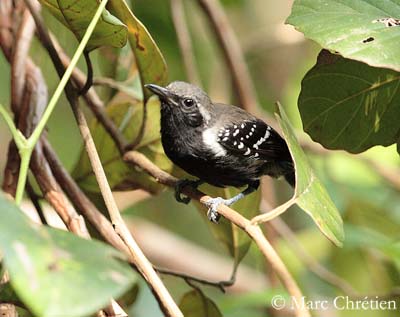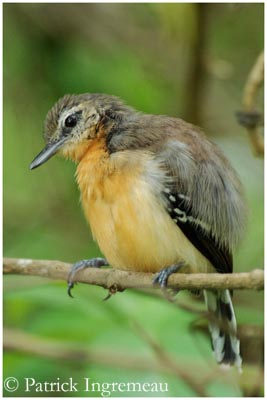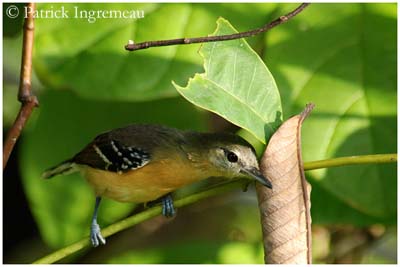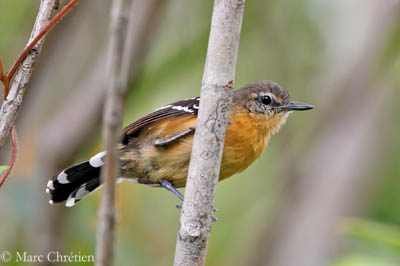
White-fringed Antwren
Formicivora grisea
Passeriforme Order – Thamnophilidae Family
BIOMETRICS:
L : 12-13 cm
Poids : 8-12 gr
DESCRIPTION:
White-fringed Antwren is resident in its range, living mainly in varied wooded areas and edges.
Adult male has dark grey-brown upperparts. Wings are darker, rather brownish-black, with tipped white coverts. We can see a white patch below the scapulars. The graduated tail is black with white external rectrices. The black central tail feathers show narrow white tips.
On the underparts, chin, throat, breast and belly are black. Breast sides and flanks are white. The undertail feathers are black tipped white. The underwing coverts are white, whereas flight feathers are black.
On the head, forehead, crown and nape are grey-brown. We can see white supercilium from forehead to the head sides. Face is black.
The bill is blackish, with greyish tip and lower mandible. Eyes are dark brown. Legs and feet are grey.
DIET:
White-fringed Antwren feeds mainly on insects and spiders from dense vegetation. Young are fed with large preys which reduce the feeding trips, and avoid bringing to the attention of predators the place of the nest. Preys are grasshoppers, larvae and caterpillars.
PROTECTION / THREATS / STATUS:
White-fringed Antwren may be uncommon to fairly common within its wide range. This species is not threatened at this moment, and benefits of extensive areas with little risk of future development.
Fr: Grisin de Cayenne
All : Braunrücken-Ameisenfänger
Esp : Hormiguerito Coicorita
Ital : Mangiaformiche grigio
Nd : Witband-miersluiper
Port : Formigueiro-pardo
Photographs by Patrick Ingremeau
His website: TAMANDUA
Photographs by Marc Chrétien
His website:
MURINUS
Text by Nicole Bouglouan
Sources:
HANDBOOK OF THE BIRDS OF THE WORLD Vol 8 by Josep del Hoyo-Andrew Elliott-David Christie - Lynx Edicions - ISBN: 8487334504
A GUIDE TO THE BIRDS OF COLOMBIA by Steven L. Hilty and William L. Brown
Princeton University Press – ISBN 069108372X


Female has similar upperparts, but she has rather buffy-white supercilium. The wings are browner with the same white pattern than in male. The underparts are cinnamon, paler on throat and belly, whereas the breast is buffer.
Juvenile resembles female. Immature male acquires black throat and breast before the complete adult plumage of the male.
White-fringed Antwren has 8 subspecies which differ in intensity of colours above, in white pattern on the tail tips, and mainly in underparts’ colours of females.
We can find: F.g. alticincta; F.g. hondae; F.g. intermedia; F.g. tobagensis; F.g. fumosa; F.g. rufiventris; F.g. orenocensis; F.g. grisea.
VOICE: SOUNDS BY XENO-CANTO
White-fringed Antwren utters a whistle “tu” ending in soft trill. It also gives an incisive “tu-ik” first slowly, and becoming faster little by little.
The song is monotonous, a series of notes repeated at the same pitch.
The calls may vary, according to the range.
HABITAT:
White-fringed Antwren frequents understory and mid-level of varied wooded habitats, mainly at edges. It is usually seen below 1000 metres of elevation, but in Venezuela, it may be found up to 1600 metres.
This species may frequent several kinds of habitats, according to the geographic range. It can be found in mangroves, thickets and seasonally flooded savannahs, thorn-scrub, edges of gallery-forests and second-growth scrub.
RANGE:
White-fringed Antwren is resident in its range in South America, from Colombia to the Guianas and Brazil, and on Tobago.
BEHAVIOUR:
White-fringed Antwren feeds mainly on insects and spiders. Both mates of the pair often forage together in thickets and at low level in vegetation. They hop and glean preys from foliage and twigs. They may be seen sometimes in small mixed flocks.
White-fringed Antwren also feeds in family groups or alone. It is very active when moving by brief hops on thin branches. It also performs fluttering flights, stops for two seconds for searching preys, and flies off again.
White-fringed Antwren has mainly horizontal posture, and wags its partially fanned tail from side to side. It also flicks its drooped wings.
It forages in varied kind of plants’ species. It climbs into vertical vines or branches, looking at the underside of branches and leaves. It performs quick stabs of the bill to reach the preys.

When an insect is flushed, is also makes sallies and pursues the prey with fluttering flight. It may perform sallies in several directions to glean items from the vegetation.
According to the range, the White-fringed Antwren may drop to the ground and forage into the leaf litter.
It swallows the small preys quickly, but the larger preys are strongly bashed against a hard surface and receive several wiping of the bill before to be eaten.
White-fringed Antwren is monogamous and probably pairs for life. It defends its territory all year round. The typical pre-copulatory display is courtship-feeding by male to female.
FLIGHT:
White-fringed Antwren has fluttering flight when foraging into foliage. The antwrens have fairly short wings, well adapted for gleaning in dense vegetation. The direct flight is rather slow and fluttering.
REPRODUCTION:
Breeding season varies according to the wide range of this species.
White-fringed Antwren’s nest is situated in horizontal fork, at about 30 cm to 3, 50 metres above the ground.
Both adults probably build the nest together. It is a woven cup made with fine plant filaments and grass stems. The nest is suspended by the rim from the fork.
Female usually lays two pale eggs with darker markings at the larger end.
Both sexes have brood patches and share the incubation, with female mainly at night and male during the day. Incubation period is not well known, but it may lasts between 14 and 20 days.
If an intruder approaches the nest, the incubating adult performs fluttering distraction display, and exposes the white interscapulars patches.
Both parents share the nesting duties and feed the young. The nesting period lasts about 13 to 15 days. The young birds usually remain long time with their parents, forming small family group and foraging together.
